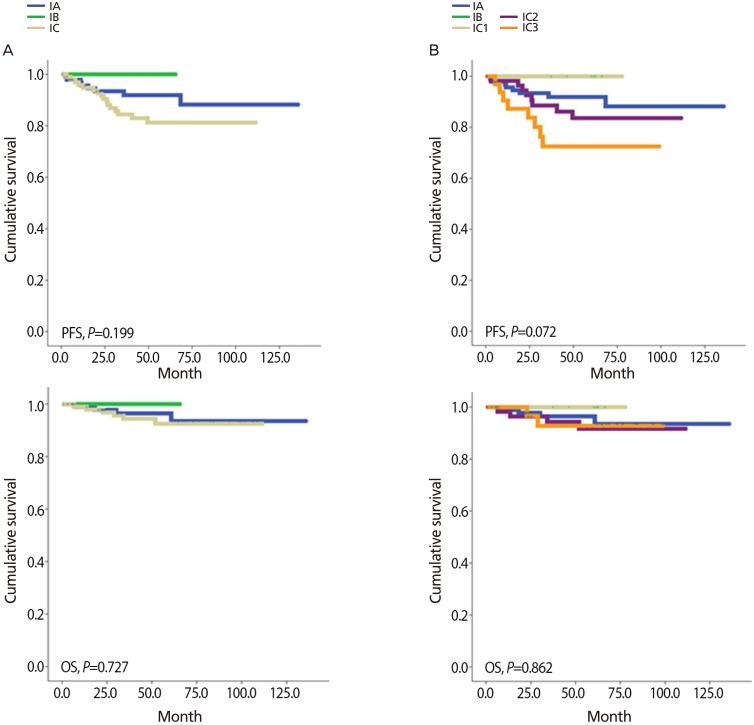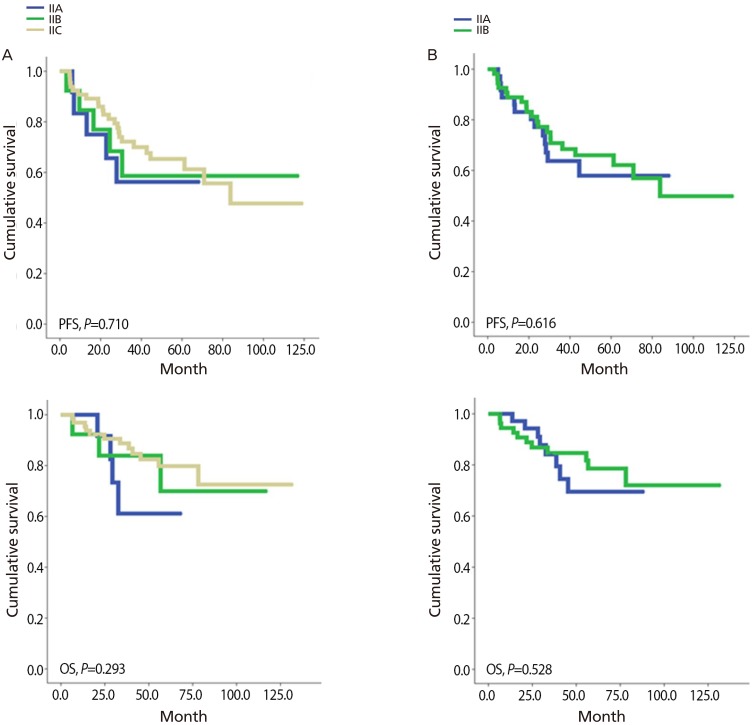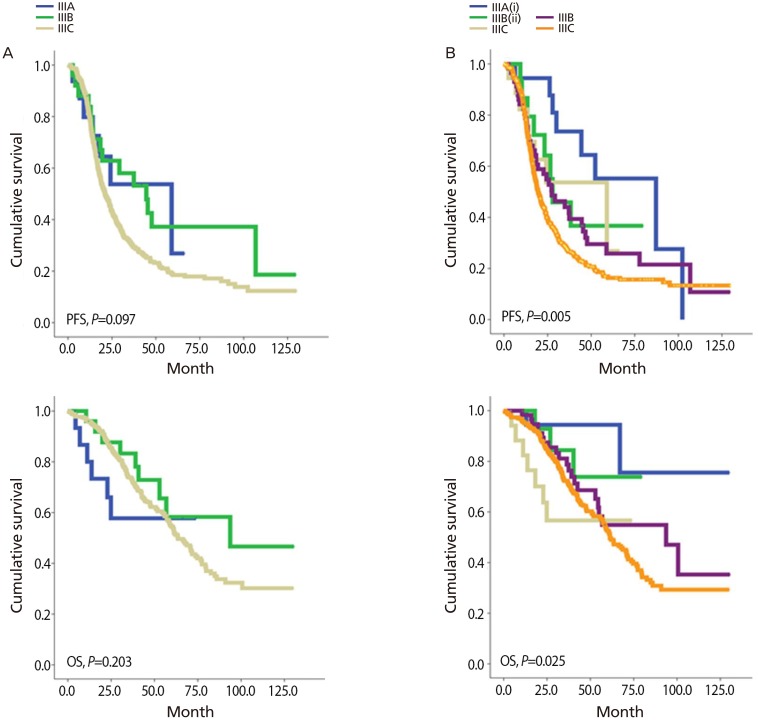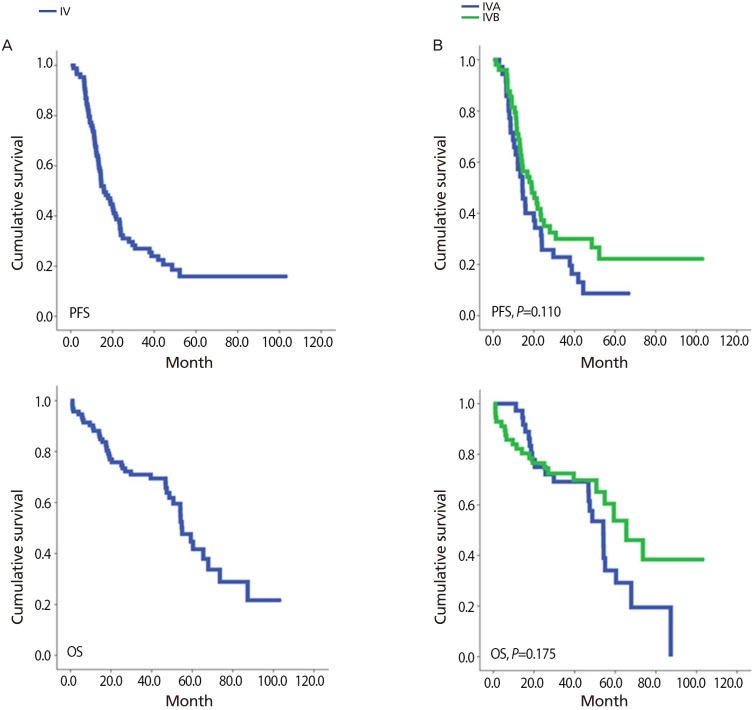Obstet Gynecol Sci.
2015 Mar;58(2):124-134. 10.5468/ogs.2015.58.2.124.
Survival analysis of revised 2013 FIGO staging classification of epithelial ovarian cancer and comparison with previous FIGO staging classification
- Affiliations
-
- 1Department of Obstetrics and Gynecology, Samsung Medical Center, Sungkyunkwan University School of Medicine, Seoul, Korea. bksong.kim@samsung.com
- KMID: 2314036
- DOI: http://doi.org/10.5468/ogs.2015.58.2.124
Abstract
OBJECTIVE
To analyze the prognostic role of revised version of International Federation of Gynecology and Obstetrics (FIGO) stage (2013) in epithelial ovarian cancer and compare with previous version staging classification
METHODS
We retrospectively enrolled patients with epithelial ovarian cancer treated at Samsung Medical Center from 2002 to 2012. We reclassified the patients based on the revised FIGO staging classification.
RESULTS
Eight hundred seventy-eight patients were enrolled (stage I, 22.8%; stage II, 10.4%; stage III, 56.2%; stage IV, 10.7%). Previous stage IC (98, 11.1%) was subdivided into IC1 (9, 1.0%), IC2 (57, 6.4%), and IC3 (32, 4.1%). In addition, previous stage IV (94, 1.7%) was categorized into IVA (37, 4.2%) and IVB (57, 6.5%) in new staging classification. Stage IIC (66, 7.5%) has been eliminated and integrated into IIA (36, 4.1%) and IIB (55, 6.2%) in revised classification. Revised FIGO stage IC3 had significant prognostic impact on PFS (hazard ratio [HR], 3.840; 95% confidence interval [CI], 1.361 to 10.83; P=0.011) and revised FIGO stage IIIC appears to be an independent, significant poor prognostic factor for PFS (HR, 2.541; 95% CI, 1.242 to 5.200; P=0.011) but not in the case of previous version of FIGO stage IIIC (HR, 1.070; 95% CI, 0.502 to 2.281; P=0.860). However, any sub-stages of both previous and revised version in stage II and IV, there was no significant prognostic role.
CONCLUSION
Revised FIGO stage has more progressed utility for informing prognosis than previous version, especially in stage I and III. For stage II and IV, further validation should be needed in large population based study in the future.
MeSH Terms
Figure
Cited by 1 articles
-
Prediction of survival outcomes in patients with epithelial ovarian cancer using machine learning methods
E Sun Paik, Jeong-Won Lee, Jeong-Yeol Park, Ju-Hyun Kim, Mijung Kim, Tae-Joong Kim, Chel Hun Choi, Byoung-Gie Kim, Duk-Soo Bae, Sung Wook Seo
J Gynecol Oncol. 2019;30(4):. doi: 10.3802/jgo.2019.30.e65.
Reference
-
1. Ferlay J, Shin HR, Bray F, Forman D, Mathers C, Parkin DM. Estimates of worldwide burden of cancer in 2008: GLOBOCAN 2008. Int J Cancer. 2010; 127:2893–2917. PMID: 21351269.
Article2. Bray F, Jemal A, Grey N, Ferlay J, Forman D. Global cancer transitions according to the Human Development Index (2008-2030): a population-based study. Lancet Oncol. 2012; 13:790–801. PMID: 22658655.
Article3. Lim MC, Moon EK, Shin A, Jung KW, Won YJ, Seo SS, et al. Incidence of cervical, endometrial, and ovarian cancer in Korea, 1999-2010. J Gynecol Oncol. 2013; 24:298–302. PMID: 24167664.
Article4. Berek JS, Novak E. Berek & Novak's gynecology. 14th ed. Philadelphia: Lippincott Williams & Wilkins;2012.5. Bakkar R, Gershenson D, Fox P, Vu K, Zenali M, Silva E. Stage IIIC ovarian/peritoneal serous carcinoma: a heterogeneous group of patients with different prognoses. Int J Gynecol Pathol. 2014; 33:302–308. PMID: 24681743.6. Onda T, Yoshikawa H, Yasugi T, Mishima M, Nakagawa S, Yamada M, et al. Patients with ovarian carcinoma upstaged to stage III after systematic lymphadenctomy have similar survival to stage I/II patients and superior survival to other stage III patients. Cancer. 1998; 83:1555–1560. PMID: 9781949.
Article7. Berek JS. Lymph node-positive stage IIIC ovarian cancer: a separate entity? Int J Gynecol Cancer. 2009; 19(Suppl 2):S18–S20. PMID: 19955908.
Article8. Kanazawa K, Suzuki T, Tokashiki M. The validity and significance of substage IIIC by node involvement in epithelial ovarian cancer: impact of nodal metastasis on patient survival. Gynecol Oncol. 1999; 73:237–241. PMID: 10329040.
Article9. Panici PB, Maggioni A, Hacker N, Landoni F, Ackermann S, Campagnutta E, et al. Systematic aortic and pelvic lymphadenectomy versus resection of bulky nodes only in optimally debulked advanced ovarian cancer: a randomized clinical trial. J Natl Cancer Inst. 2005; 97:560–566. PMID: 15840878.
Article10. Cliby WA, Aletti GD, Wilson TO, Podratz KC. Is it justified to classify patients to Stage IIIC epithelial ovarian cancer based on nodal involvement only? Gynecol Oncol. 2006; 103:797–801. PMID: 17052746.
Article11. Ferrandina G, Scambia G, Legge F, Petrillo M, Salutari V. Ovarian cancer patients with "node-positive-only" stage IIIC disease have a more favorable outcome than stage IIIA/B. Gynecol Oncol. 2007; 107:154–156. PMID: 17614126.
Article12. Baek SJ, Park JY, Kim DY, Kim JH, Kim YM, Kim YT, et al. Stage IIIC epithelial ovarian cancer classified solely by lymph node metastasis has a more favorable prognosis than other types of stage IIIC epithelial ovarian cancer. J Gynecol Oncol. 2008; 19:223–228. PMID: 19471577.
Article13. Prat J. FIGO Committee on Gynecologic Oncology. Staging classification for cancer of the ovary, fallopian tube, and peritoneum. Int J Gynaecol Obstet. 2014; 124:1–5. PMID: 24219974.
Article14. Vergote I, De Brabanter J, Fyles A, Bertelsen K, Einhorn N, Sevelda P, et al. Prognostic importance of degree of differentiation and cyst rupture in stage I invasive epithelial ovarian carcinoma. Lancet. 2001; 357:176–182. PMID: 11213094.
Article15. Bakkum-Gamez JN, Richardson DL, Seamon LG, Aletti GD, Powless CA, Keeney GL, et al. Influence of intraoperative capsule rupture on outcomes in stage I epithelial ovarian cancer. Obstet Gynecol. 2009; 113:11–17. PMID: 19104354.
Article16. Seidman JD, Yemelyanova AV, Khedmati F, Bidus MA, Dainty L, Boice CR, et al. Prognostic factors for stage I ovarian carcinoma. Int J Gynecol Pathol. 2010; 29:1–7. PMID: 19952945.
Article17. Chan JK, Tian C, Monk BJ, Herzog T, Kapp DS, Bell J, et al. Prognostic factors for high-risk early-stage epithelial ovarian cancer: a Gynecologic Oncology Group study. Cancer. 2008; 112:2202–2210. PMID: 18348296.18. Obermair A, Fuller A, Lopez-Varela E, van Gorp T, Vergote I, Eaton L, et al. A new prognostic model for FIGO stage 1 epithelial ovarian cancer. Gynecol Oncol. 2007; 104:607–611. PMID: 17092548.
Article19. Kim HS, Ahn JH, Chung HH, Kim JW, Park NH, Song YS, et al. Impact of intraoperative rupture of the ovarian capsule on prognosis in patients with early-stage epithelial ovarian cancer: a meta-analysis. Eur J Surg Oncol. 2013; 39:279–289. PMID: 23273873.
Article20. Ayhan A, Gultekin M, Dursun P, Dogan NU, Aksan G, Guven S, et al. Metastatic lymph node number in epithelial ovarian carcinoma: does it have any clinical significance? Gynecol Oncol. 2008; 108:428–432. PMID: 18249232.
Article21. Lee HP. Annual report of gynecologic cancer registry program in Korea: 1991-2004. Korean J Obstet Gynecol. 2008; 51:1411–1420.22. Dembo AJ, Davy M, Stenwig AE, Berle EJ, Bush RS, Kjorstad K. Prognostic factors in patients with stage I epithelial ovarian cancer. Obstet Gynecol. 1990; 75:263–273. PMID: 2300355.
- Full Text Links
- Actions
-
Cited
- CITED
-
- Close
- Share
- Similar articles
-
- Revised International Federation of Gynecology and Obstetrics (FIGO) staging systems in gynecologic malignancies
- Uterine Cervical Cancer: Emphasis on Revised FIGO Staging 2018 and MRI
- Revised FIGO Staging System
- The Clinical Analysis of Endometrial Cancer by Surgical Staging
- Prognostic significance of tumor laterality in advanced ovarian cancer





